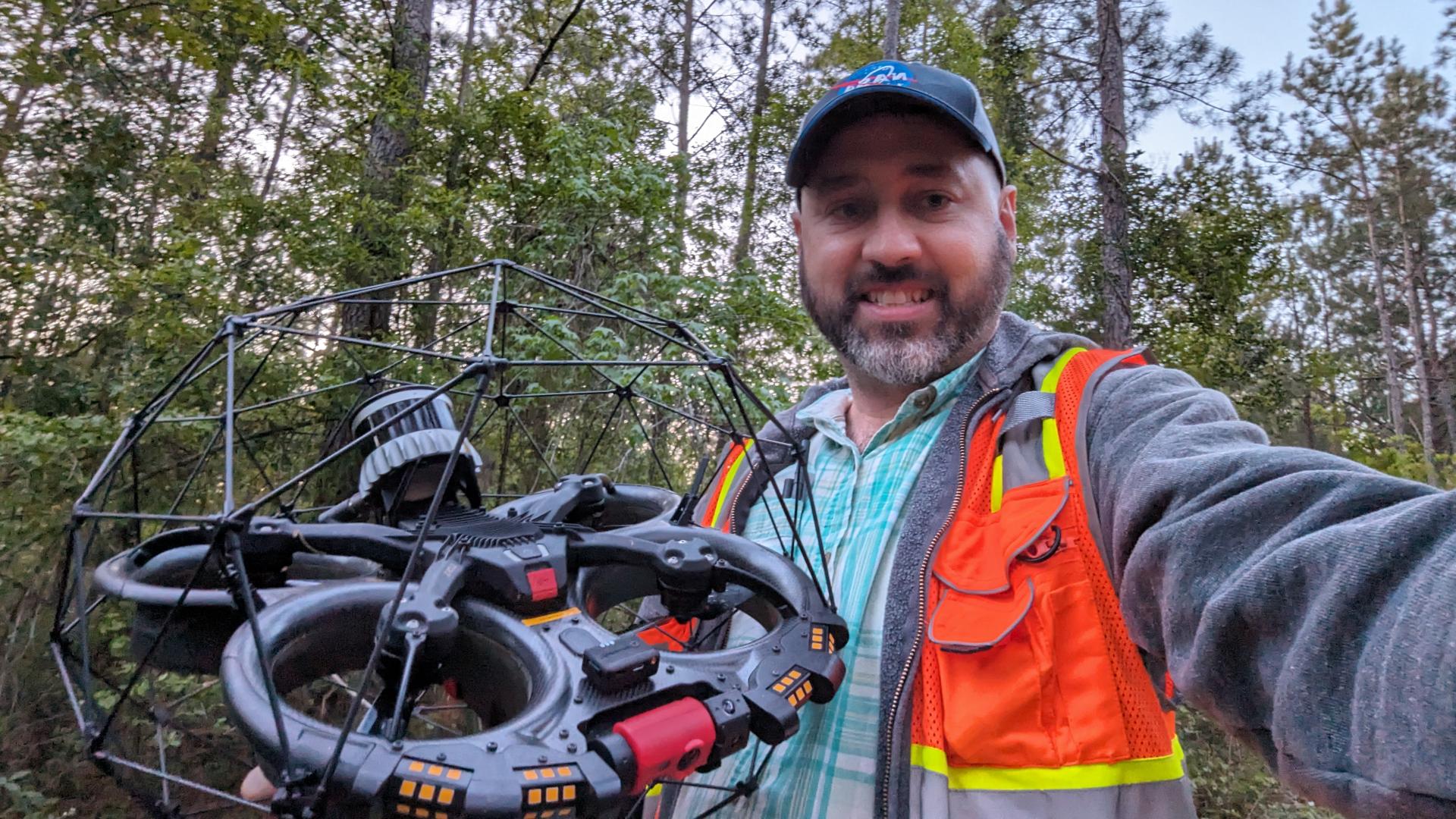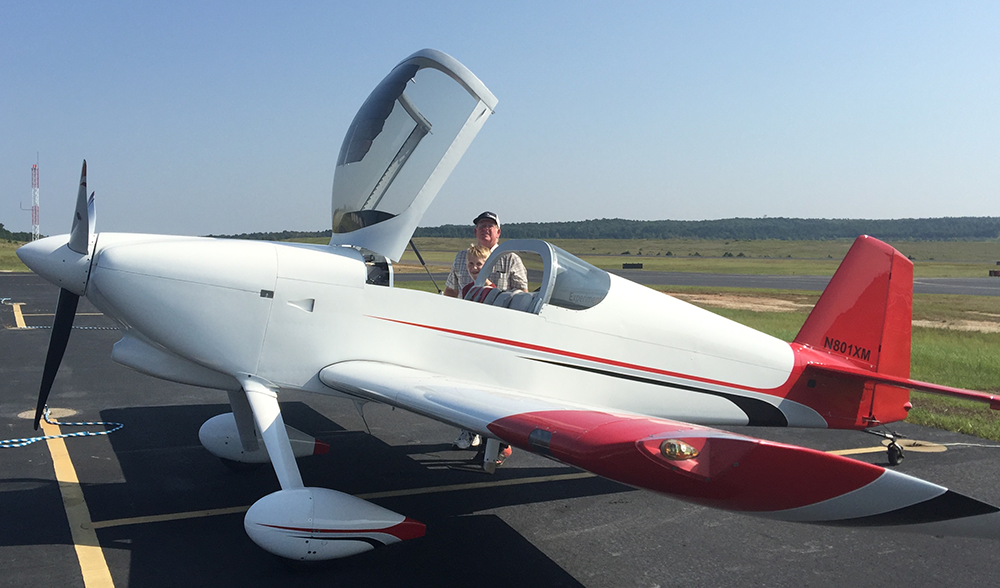
James tests the Elios 3 drone outside near Arcadia, Louisiana. “My curiosity got me here,” James says. “When I started at Sutton OSB, their process control team allowed me to learn their systems. That led to training classes, and then working on projects, completing integrations and leading projects, which all led here. Sometimes, we just have to take a leap and try something new. If it fails, we still end up learning a lot, and we can turn that knowledge into future improvements.”
James Liston’s view of our manufacturing facilities is a little different than most. As an IT technical support engineer based at our OSB facility in Elkin, North Carolina, he examines every tiny detail of every automated process, seeking ways to drive improvements through technology.
“Our mills are more like pinball machines than people realize,” James says. “It’s one big network of flippers, bumpers and scoring circuits moving product through each process. You have to understand how they interact and get your timing just right to hit the goal.”
For James, that means integrating advanced technologies into the process. On any given day he may be working with artificial intelligence, cameras that peer deep into machinery, lasers that measure boards in three dimensions, or even drones flying through ductwork or inside machinery inspecting for buildup.
“My number one goal is to empower the people I work with, whether that means equipping a business leader with a travel monitor so they can work on the go or literally giving operators an inside look at the machines they’re running,” he says.
James and his daughters Tesla Clementine, Corinna Lynn and Emma Jane exploring Mount Airy, North Carolina. The girls are wearing nature headdresses the family made.
MEET JAMES
Your title is IT technical support engineer. Tell us what you do.
I’m one of the few people we have on the Wood Products IT team who are both an operational technology/process control engineer and an IT engineer. I work with both information technology and process control, also called operational technology, which is the automation side of our manufacturing operations that run factory components like the presses, pumps, robotics, conveyors and fans.
What led you to choose this job?
My grandfather, Don Haugh, worked on electronics technology in the U.S. Navy — he took the USS Enterprise aircraft carrier on its maiden voyage around the planet in 1962. When he got out of service, he started a company that sold equipment for over-the-air communications. I learned a lot about C-band satellites and coaxial networks when I was just 8 or 9 years old! When I was old enough, I worked for Grandpa and installed antennas on radio towers on hotels and other large buildings. That led to fixing and troubleshooting all kinds of equipment and computers. I started a computer and business consulting business during college and grew it for several years until selling. I joined Weyerhaeuser in 2013, and now here I am! I get to work on state-of-the-art, world-class automation, which blows my mind.
Tell us what your average day is like.
Much of my work is priority setting and figuring out a risk matrix — what can wait until tomorrow, and what can’t. I can have great plans and ambitions for the immediate future, but then something breaks, and fixing it becomes the top priority.
Is there anything about your job that would surprise people?
Sometimes it’s like playing a very expensive, high-stakes video game. I fly an indoor inspection drone called the Elios 3 inside our equipment as part of our cutting-edge unmanned aerial vehicle team. It takes 3D LiDAR measurements, visual and thermal video inside the duct work and under and around OSB presses. These provide important data to our fire audit, safety and environmental teams. It’s really fun and satisfying to apply emerging technologies to boost safety and provide greater insight. And my work with the predictive technology team has been a great opportunity to learn more about machine health and operational excellence.
What’s your favorite part of your job?
Making people happier and safer through ergonomics, process improvements, system upgrades and boosting efficiency. That can be as small as revamping a workspace or as big as getting involved in a major capital project introducing cutting-edge technology. It means everything to me when someone says I improved their life in some way.
I also love that my job is challenging and evolving. I love building the “mill of the future” by leveraging mature and emerging technologies.
James was one of the employees featured in our recent innovation video, released earlier this year.
You must have some challenges. What are they?
Sometimes when we’re trying to update technology that’s several generations old, I have to convince people to leap forward to the cutting-edge solution instead of making incremental changes. Big changes like that can be scary, and sometimes people worry it will be too difficult to adjust to. But usually, it works out for the best.
What advice would you give people who want a job like yours?
Just like I tell my daughters, be kind. Be curious, compassionate, empathetic, professional and courageous, and everything else will fall into place.
What are your career aspirations?
I would love to have a broader impact on the technologies we use, maybe through leading a technology-driven team or acting as an engineering advisor. I think I have high-value skills that could be well-suited to that sort of work.
Tell us about your other interests. What do you like to do when you’re not at work?
I have three daughters, who keep me very busy. Since we recently moved to Mount Airy, North Carolina, from Sutton, West Virginia, we’ve spent a lot of time exploring. We love to walk around towns, look for new playgrounds, and check out the Blue Ridge Mountains.
The family explores the North Carolina zoo this June. “I’ve taken every opportunity to move forward, even if the direction is initially sideways,” James says. “I’ve provided full-time support to Elkin OSB, Sutton OSB, Arcadia OSB and Buckhannon EWP, along with two remote wood yards. Eventually, you’ll get somewhere new.”


